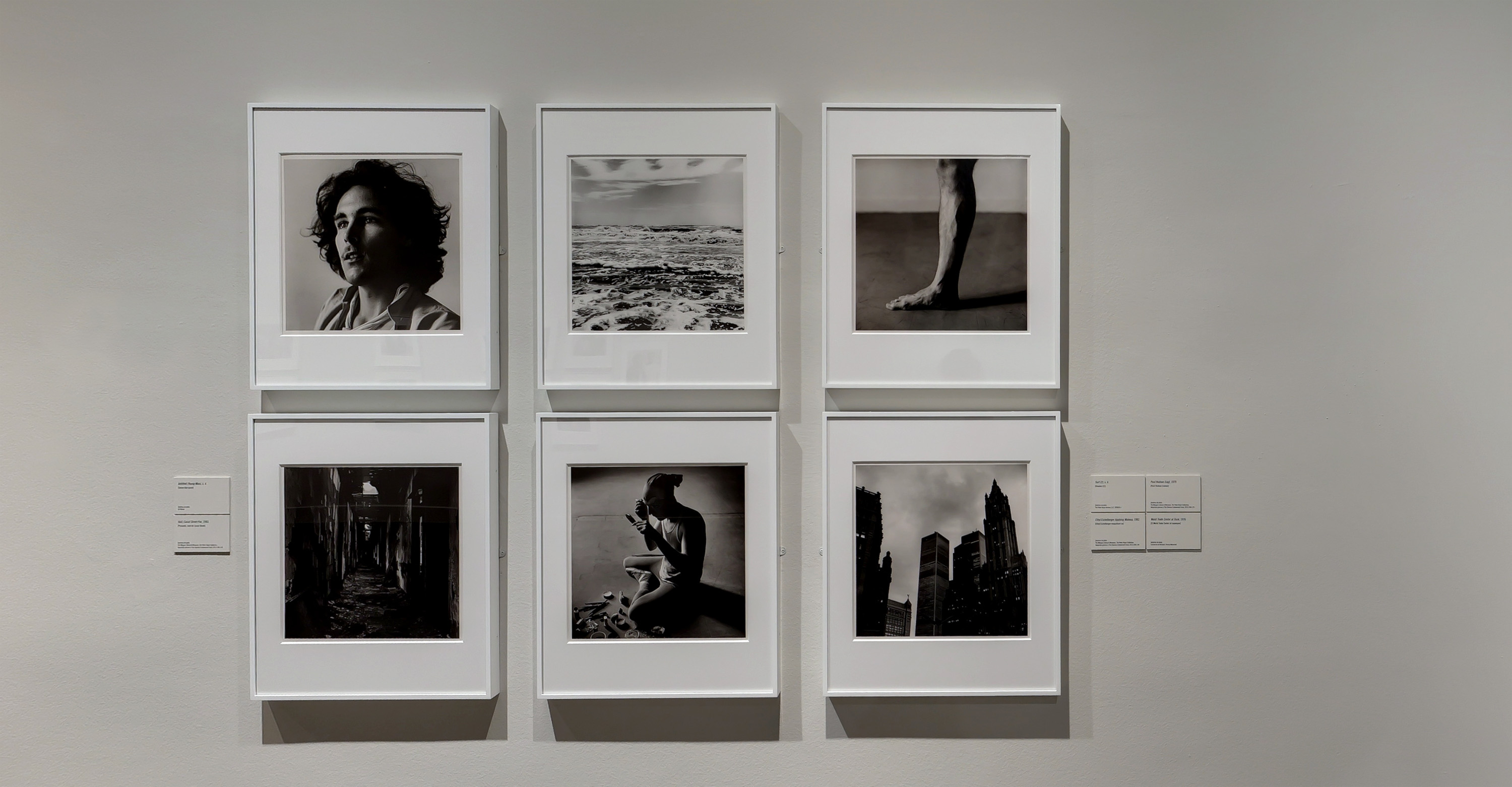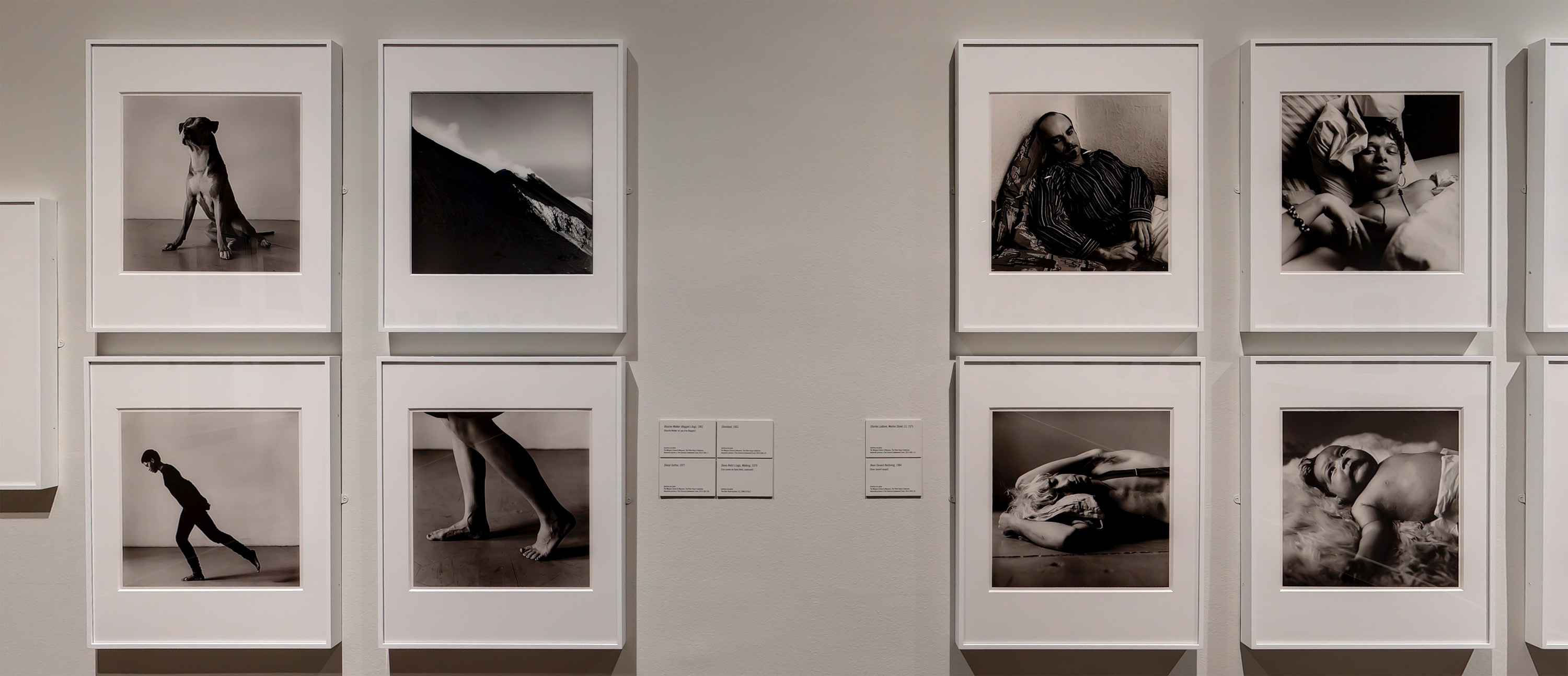Exhibition dates: 27th January – 30th April 2017
Curator: Joel Smith, “Richard L. Menschel Curator” and Director of the Department of Photography at the Morgan Library & Museum
Peter Hujar: Speed of Life has been organised by Fundación MAPFRE, Barcelona, and The Morgan Library & Museum, New York. The exhibition and its travelling schedule have been made possible by the Terra Foundation for American Art.
Peter Hujar (American, 1934-1987)
Horse in West Virginia Mountains
1969
Gelatina de plata
Colección de Richard y Ronay Menschel
© The Peter Hujar Archive, LLC. Cortesía Pace/MacGill Gallery, Nueva York, and Fraenkel Gallery, San Francisco
A love letter to Peter Hujar
You jumped so high
the boy on a raft
saluting the sky
absorbed in his craft
Of rhythm and eros
you offer no excess
just intimacy, connection
a timeless … transience
The line of skyscrapers, the lines of a thinker
the gaze of a baby, the eyes of a dreamer
two cows look direct, as direct as can be
and chrysanthemums and roses lay death near thee
Contortions and compression
of time and space
the twist of a wrist, the surge of a river
a certain, poignant – tenderness
In love with photography
and the stories it tells
A troubled man
brought out of his shell
You left us too soon
you beautiful spirit
your portraits of life
loved, immortal – never finished
Marcus
Many thankx to Fundación MAPFRE for allowing me to publish the photographs in the posting. Please click on the photographs for a larger version of the image.
See more Peter Hujar images on The Guardian website.
I want you to talk about me in a low voice. When people talk about me, I want them to do it by whispering.
Peter Hujar
He was charismatic and complicated and, it turned out, deeply insecure, with a damaging family history he kept mostly to himself… Peter was, in a way, at his most moving when taking photographs. He was so absorbed by it. Peter was in many ways a very tortured man, and I felt like when he was taking photographs, he wasn’t. I had other friends who were photographers, but not like Peter. Peter was so profoundly absorbed and engaged by it. He was never not a photographer.
Vince Aletti
Installation views of Peter Hujar: Speed of Life at Fundación MAPFRE, Barcelona
Fundación MAPFRE is delighted to be presenting Peter Hujar: Speed of Life, a retrospective exhibition on the American photographer Peter Hujar. Offering the most detailed account of the artist’s work to date, from the 1950s to his death in New York in 1987, it will be on display between January 27 and April 30, 2017 at the Fundación MAPFRE’s Casa Garriga i Nogués exhibition space (Calle Diputació, 250) in Barcelona.
Hujar was a portraitist in everything he did. Regardless of the subject of the work – a lover, an underground theatre actor, a goose, the surface of the Hudson River, or the placid features of his own face – what moved and motivated him was the spark of encounter and exchange between artist and other. Hujar’s serene, meditative, square-format photographs confer gravity on the object of his attention, granting it an eternal moment’s pause within the rush of passing time.
Little recognised during his own lifetime, Hujar published only one book of photographs, Portraits in Life and Death, but his output is today recognised as distinctive. His portraits combine disclosure and secrecy, ferocity and peace. Hujar’s career involved both a quest for recognition in the world of fashion photography – the photographers he admired most were Irving Penn and Richard Avedon – and a more solitary, almost completely uncompensated body of work in which he depicted the creative and intellectual New York that he knew and admired.
The present exhibition follows Peter Hujar’s method of presenting his work. Rather than show his photographs in isolation or in an linear or chronological arrangements, he preferred to present them in dynamic, surprising and sometimes disconcerting juxtapositions.
Press release from Fundación MAPFRE
Four keys
Peter Hujar’s work falls within the photographic tradition of portraiture: he was a portraitist in everything he did. Whatever the subject – a lover, an actor, a horse, the surface of the Hudson River, or the gentle features of his own face – what moved and motivated Hujar was the spark in the encounter and the exchange between the artist and his subject, establishing a direct relationship with whatever he portrayed thereby revealing its true nature.
One of the themes reflected in Hujar’s work is homosexuality. These were the years of the first Gay Liberation movements and the famous Stonewall riots. Hujar lived close to the Stonewall Inn, and his partner at the time, Jim Fouratt, came onto the scene the night of the police raid and founded the Gay Liberation Front. Hujar was not an activist, though he attended the group’s first meeting and contributed his well-known photograph which would become the image for the Gay Liberation Front Poster, 1970.
The route followed by the exhibition reflects the preferences of the artist, who systematically chose to present his photographs in vibrant, surprising and sometimes disturbing Most of the photographs are grouped into sets, some of which reflect the artist’s recurrent concerns, while others exemplify his interest in emphasising diversity and the internal contradictions in his work.
A distinguishing feature of his art is the invisibility of technique in his photographs and yet simultaneously his preoccupation with and care over it. Hujar produced his own copies and was also considered a good printer.
Text from the Fundación MAPFRE website
Peter Hujar (American, 1934-1987)
La Marchesa Fioravanti
1958
Gelatina de plata
The Peter Hujar Archive
© The Peter Hujar Archive, LLC. Cortesía Pace/MacGill Gallery, Nueva York, and Fraenkel Gallery, San Francisco
Peter Hujar (American, 1934-1987)
Stromboli
1963
Gelatina de plata
The Morgan Library & Museum, The Peter Hujar Collection
Adquirida gracias a The Charina Endowment Fund
© The Peter Hujar Archive, LLC. Cortesía Pace/MacGill Gallery, Nueva York, and Fraenkel Gallery, San Francisco
Peter Hujar (American, 1934-1987)
Palermo Catacombs (11)
1963
Gelatina de plata
Colección de Allen Adler and Frances Beatty Adler
© The Peter Hujar Archive, LLC. Cortesía Pace/MacGill Gallery, Nueva York, and Fraenkel Gallery, San Francisco
Peter Hujar (American, 1934-1987)
St. Patrick’s, Easter Sunday
1976
Gelatina de plata
The Morgan Library & Museum, The Peter Hujar Collection
Adquirida gracias a The Charina Endowment Fund
© The Peter Hujar Archive, LLC. Cortesía Pace/MacGill Gallery, Nueva York, and Fraenkel Gallery, San Francisco
Artist biography
Peter Hujar was born in Trenton, New Jersey, in 1934 and grew up in the countryside with his Polish immigrant grandparents. When he was eleven his mother, a waitress, brought him to live with her in Manhattan.
Interested in photography from childhood, after graduating from high school in 1953 Hujar worked as an assistant in the studios of magazine professionals and aspired to work in fashion like his idols Lisette Model, Irving Penn, and Richard Avedon.
Between 1958 and 1963 Hujar lived mainly in Italy with two successive partners, artists Joseph Raffael and Paul Thek. After studying for a year at a filmmaking school in Rome he returned to Manhattan, where he moved in the circles of writer Susan Sontag and Andy Warhol’s Factory. From 1968 to 1972 he pursued a freelance career in fashion photography, publishing over a dozen features in Harper’s Bazaar and GQ before concluding that the hustle of magazine work “wasn’t right for me.”
In 1973 Hujar definitively renounced his professional aspirations for a life of creative poverty in New York’s East Village. Living in a loft above a theatre at Twelfth Street and Second Avenue, he took paying jobs only when necessary in order to focus on the work that truly motivated him. He photographed the artists he knew and respected, animals, the nude body, and New York as he knew it, a city then in serious economic decline. In his book Portraits in Life and Death (1976) he combined intimate studies of his rarefied downtown coterie (painters, performers, choreographers, and writers such as Sontag and William S. Burroughs) with portraits of mummies in the Palermo Catacombs that he had made during a visit with Thek thirteen years earlier. His focus on mortality would intensify and find its purpose in the 1980s, when the AIDS epidemic ravaged gay populations in New York and worldwide.
Briefly a lover and subsequently a mentor to the young artist David Wojnarowicz, in his last seven years Hujar continued chronicling a creative downtown subculture that was fast becoming unsustainable in the context of the increasing power of money. His most frequent subject in these years was his neighbour and friend Ethyl Eichelberger, a drag performer whom he called “the greatest actor in America.” With Wojnarowicz, Hujar made expeditions to the depressed areas around New York, photographing industrial ruins in Queens, neighbourhoods of Newark, New Jersey, that had been destroyed in the riots of the late 1960s, and the abandoned Hudson River piers of lower Manhattan, sites of sexual exploits by night and guerilla art installations by day. Hujar died in New York on Thanksgiving Day, 1987, around eleven months after being diagnosed with AIDS.
Throughout his life Hujar stubbornly aligned himself with what he called the “All-In people”: artists committed to a creative course all their own, unconcerned with mass-market acclaim. At the same time he both disdained and bitterly wished for public recognition such as that achieved by his famous contemporaries Diane Arbus – eleven years his senior and respected by him – and Robert Mapplethorpe, who was twelve years younger and whom he considered a facile operator. During the thirty years since Hujar’s death the highly localised downtown public that knew his work has all but completely passed into history, while a vastly expanded photography audience around the world has become familiar with specific facets of his work, such as his indelible 1973 image Candy Darling on her Deathbed, and his soulful portraits of animals. In Peter Hujar: Speed of Life what comes to light is a broader assessment of his unique oeuvre, which was diverse and enduring. Many of the subjects populating this retrospective are familiar, even iconic faces of their era, but what can be seen more clearly today is the vision of the artist who unites them, himself a great and singular talent of the post-war decades in American art.
Peter Hujar (American, 1934-1987)
Cindy Luba as Queen Victoria
1973
Gelatina de plata
The Morgan Library & Museum, The Peter Hujar Collection
© The Peter Hujar Archive, LLC. Cortesía Pace/MacGill Gallery, Nueva York, and Fraenkel Gallery, San Francisco
Peter Hujar (American, 1934-1987)
David Warrilow (1)
1985
Gelatina de plata
The Morgan Library & Museum, The Peter Hujar Collection
© The Peter Hujar Archive, LLC. Cortesía Pace/MacGill Gallery, Nueva York, and Fraenkel Gallery, San Francisco
Peter Hujar (American, 1934-1987)
Flowers for the Dead, Mazatlán, Mexico (2)
1977
Gelatina de plata
The Morgan Library & Museum, The Peter Hujar Collection
© The Peter Hujar Archive, LLC. Cortesía Pace/MacGill Gallery, Nueva York, and Fraenkel Gallery, San Francisco
Peter Hujar (American, 1934-1987)
Pascal Imbert Scarred Abdomen
1980
Gelatina de plata
The Morgan Library & Museum, The Peter Hujar Collection
© The Peter Hujar Archive, LLC. Cortesía Pace/MacGill Gallery, Nueva York, and Fraenkel Gallery, San Francisco
Peter Hujar (American, 1934-1987)
Grass, Port Jefferson, New York
1984
Gelatina de plata
The Morgan Library & Museum, The Peter Hujar Collection
© The Peter Hujar Archive, LLC. Cortesía Pace/MacGill Gallery, Nueva York, and Fraenkel Gallery, San Francisco
Peter Hujar (American, 1934-1987)
Paul Hudson (Leg)
1979
Gelatina de plata
The Morgan Library & Museum, The Peter Hujar Collection
© The Peter Hujar Archive, LLC. Cortesía Pace/MacGill Gallery, Nueva York, and Fraenkel Gallery, San Francisco
Peter Hujar (American, 1934-1987)
Robyn Brentano (1)
1975
Gelatina de plata
The Morgan Library & Museum, The Peter Hujar Collection
© The Peter Hujar Archive, LLC. Cortesía Pace/MacGill Gallery, Nueva York, and Fraenkel Gallery, San Francisco
Structure of the exhibition
The exhibition includes 160 photographs that offer an exploration of the career of this American photographer, with works loaned from the collection of the Morgan Library & Museum and nine other collections. The result is the most detailed account of Peter Hujar’s work presented to date.
In its structure the exhibition takes account of Hujar’s preference for presenting his photographs in vivid, startling, and even puzzling juxtapositions. Although following a broadly chronological order, with formative work from the 1950s and 1960s concentrated in the first half and later photographs at the end, the visual and creative continuities that spanned the duration of Hujar’s artistic life are emphasised as the visitor follows the sequence of works.
Most of the photographs are presented in groups of three to eight images, some of which showcase enduring preoccupations of the artist while others exemplify his desire to stress the diversity and internal contradictions of his work.
Thus, for the final exhibition of his life, held at the Gracie Mansion Gallery in the East Village in January 1986, Hujar spent several days arranging seventy photographs into thirty-five tightly spaced vertical pairs, taking care not to let any single genre of image appear twice in a row. At the start of the present exhibition, a six-photograph grid pays homage to this method by presenting a checkerboard-format conversation between three images made in controlled indoor conditions and three exterior views. The subjects, in order, are: a man’s bare leg with the foot planted firmly on the studio floor; waves rolling in on an ocean beach; a portrait of an unidentified young man; the World Trade Center at sunset; Ethyl Eichelberger applying makeup before a performance; and a dark burned-out hallway in the ruins of the Canal Street pier.
The catalogue
The catalogue that accompanies the exhibition includes texts by its curator Joel Smith and by Philip Gefter and Steve Turtell, making it a reference work for a detailed knowledge of Peter Hujar’s work from the 1950s until his death in 1987.
Peter Hujar (American, 1934-1987)
Peggy Lee
1974
Gelatina de plata
The Peter Hujar Archive
© The Peter Hujar Archive, LLC. Cortesía Pace/MacGill Gallery, Nueva York, and Fraenkel Gallery, San Francisco
Peter Hujar (American, 1934-1987)
Hudson River
1975
Gelatina de plata
The Morgan Library & Museum, The Peter Hujar Collection
Adquirida gracias a The Charina Endowment Fund
© The Peter Hujar Archive, LLC. Cortesía Pace/MacGill Gallery, Nueva York, and Fraenkel Gallery, San Francisco
Peter Hujar (American, 1934-1987)
Mural at Piers
1983
Gelatina de plata
The Peter Hujar Archive
© The Peter Hujar Archive, LLC. Cortesía Pace/MacGill Gallery, Nueva York, and Fraenkel Gallery, San Francisco
Peter Hujar (American, 1934-1987)
Ethyl Eichelberger as Minnie the Maid
1981
Gelatina de plata
The Morgan Library & Museum, The Peter Hujar Collection
Adquirida gracias a The Charina Endowment Fund
© The Peter Hujar Archive, LLC. Cortesía Pace/MacGill Gallery, Nueva York, and Fraenkel Gallery, San Francisco
Peter Hujar (American, 1934-1987)
Steel Ruins 13
1976
Gelatina de plata
The Morgan Library & Museum, The Peter Hujar Collection
Adquirida gracias a The Charina Endowment Fund
© The Peter Hujar Archive, LLC. Cortesía Pace/MacGill Gallery, Nueva York, and Fraenkel Gallery, San Francisco
Peter Hujar (American, 1934-1987)
Gary in Contortion (1)
1979
Gelatina de plata
The Morgan Library & Museum, The Peter Hujar Collection
Adquirida gracias a The Charina Endowment Fund
© The Peter Hujar Archive, LLC. Cortesía Pace/MacGill Gallery, Nueva York, and Fraenkel Gallery, San Francisco
Peter Hujar (American, 1934-1987)
Self-Portrait Jumping (1)
1974
Gelatina de plata
The Morgan Library & Museum, The Peter Hujar Collection
Adquirida gracias a The Charina Endowment Fund
© The Peter Hujar Archive, LLC. Cortesía Pace/MacGill Gallery, Nueva York, and Fraenkel Gallery, San Francisco
Peter Hujar (American, 1934-1987)
Candy Darling on Her Deathbed
1973
Gelatina de plata
Colección de Richard and Ronay Menschel
© The Peter Hujar Archive, LLC. Cortesía Pace/MacGill Gallery, Nueva York, and Fraenkel Gallery, San Francisco
Peter Hujar (American, 1934-1987)
Chloe Finch
1981
Gelatina de plata
The Morgan Library & Museum, The Peter Hujar Collection
Adquirida gracias a The Charina Endowment Fund
© The Peter Hujar Archive, LLC. Cortesía Pace/MacGill Gallery, Nueva York, and Fraenkel Gallery, San Francisco
Peter Hujar (American, 1934-1987)
Butch and Buster
1978
Gelatina de Plata
Colección de John Erdman and Gary Schneider
© The Peter Hujar Archive, LLC. Cortesía Pace/MacGill Gallery, Nueva York, and Fraenkel Gallery, San Francisco
Peter Hujar (American, 1934-1987)
David Wojnarowcz Reclining (2)
1981
Gelatina de plata
The Morgan Library & Museum, The Peter Hujar Collection
Adquirida gracias a The Charina Endowment Fund
© The Peter Hujar Archive, LLC. Cortesía Pace/MacGill Gallery, Nueva York, and Fraenkel Gallery, San Francisco
Peter Hujar (American, 1934-1987)
John McClellan
1981
Gelatina de plata
The Morgan Library & Museum, The Peter Hujar Collection
Adquirida gracias a The Charina Endowment Fund
© The Peter Hujar Archive, LLC. Cortesía Pace/MacGill Gallery, Nueva York, and Fraenkel Gallery, San Francisco
Peter Hujar (American, 1934-1987)
Susan Sontag
1975
Gelatina de plata
The Morgan Library & Museum, The Peter Hujar Collection
Adquirida gracias a The Charina Endowment Fund
© The Peter Hujar Archive, LLC. Cortesía Pace/MacGill Gallery, Nueva York, and Fraenkel Gallery, San Francisco
Peter Hujar (American, 1934-1987)
New York: Sixth Avenue (1)
1976
Gelatina de plata
The Morgan Library & Museum, The Peter Hujar Collection
Adquirida gracias a The Charina Endowment Fund
© The Peter Hujar Archive, LLC. Cortesía Pace/MacGill Gallery, Nueva York, and Fraenkel Gallery, San Francisco
Peter Hujar (American, 1934-1987)
Boy on Raft
1978
Gelatina de plata
The Morgan Library & Museum, The Peter Hujar Collection
© The Peter Hujar Archive, LLC. Cortesía Pace/MacGill Gallery, Nueva York, and Fraenkel Gallery, San Francisco
Cover of the catalogue for the exhibition Peter Hujar: Speed of Life at Fundación MAPFRE, Barcelona featuring the Peter Hujar image Boy on Raft (1978)
Fundación MAPFRE – Instituto de Cultura
Casa Garriga i Nogués exhibition space
Calle Diputació, 250
Barcelona
Opening hours:
Tuesday to Sundays (and holidays): 11am – 7pm
Closed Mondays








































You must be logged in to post a comment.